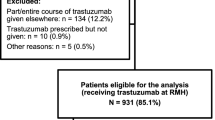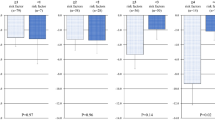Abstract
Purpose
The field of cardio-oncology aims to optimize the cardiac health of cancer patients. The goals of this study are to (1) describe the demographics of a cardio-oncology clinic and (2) apply the American Society of Clinical Oncology (ASCO) cardiac risk stratification guidelines among breast cancer patients to assess the development of cardiovascular events, primarily heart failure (HF).
Methods
We performed a retrospective chart review on 203 consecutive cardio-oncology patients who were seen between January 2019 and March 2020. Mean follow-up for the cohort was 29.2 ± 3.1 months (range 0–113). We applied the ASCO guidelines to the breast cancer subgroup.
Results
The plurality of patients 82/203 (40%) referred to clinic had breast cancer. The most common reason for referral was asymptomatic left ventricular (LV) dysfunction or HF (40%). Only 36/203 (18%) of patients were referred for a pre-chemotherapy evaluation. In breast cancer patients, there was a trend toward significance in up-titrating or initiating beta-blockers in the high vs. low risk ASCO groups [46/69 (67%) vs. 5/13 (38%), p = 0.054]. Approximately 13/82 (16%) of breast cancer patients required alterations to their anti-cancer therapy. HF events occurred in 1/36 (3%) of cancer treatment naïve patients and 14/167 (8%) of those with prior therapy, specifically 9% of the breast cancer subset.
Conclusion
Our study provides insight into referral practices, interventions, and outcomes at a cardio-oncology clinic. Furthermore, breast cancer patients continue to have high rates of HF. These findings suggest a need to shift referral practices upstream for a pre-chemotherapy evaluation to optimize cardiovascular health.


Similar content being viewed by others
Data availability
Not applicable.
Code availability
Not applicable.
References
Snipelisky D et al (2017) How to develop a cardio-oncology clinic. Heart Fail Clin 13(2):347–359
Zaorsky NG et al (2017) Causes of death among cancer patients. Ann Oncol 28(2):400–407
Mehta LS et al (2018) Cardiovascular disease and breast cancer: where these entities intersect: a scientific statement from the American Heart Association. Circulation 137(8):e30–e66
Cardinale D et al (2008) Cardio-oncology: a new medical issue. Ecancermedicalscience. https://doi.org/10.3332/ecancer.2008.126
Gujral DM et al (2016) Organisation and models of cardio-oncology clinics. Int J Cardiol. https://doi.org/10.1016/j.ijcard.2016.03.237
Barac A et al (2015) Cardiovascular health of patients with cancer and cancer survivors: a roadmap to the next level. J Am Coll Cardiol 65(35):2739–2746
Cirugliano G et al (2020) Management of cardiac disease in cancer patients throughout oncological treatment: ESMO consensus recommendations. Ann Oncol 31(2):171–190
Lancellotti P et al (2013) Expert consensus for multi-modality imaging evaluation of cardiovascular complications of radiotherapy in adults: a Report from the European Association of Cardiovascular Imaging and the American Society of Echocardiography. J Am Soc Echocardiogr 26(9):1013–1032
Zamorano JL et al (2016) 2016 ESC Position Paper on Cancer Treatments and Cardiovascular Toxicity developed under the auspices of the ESC Committee for Practice Guidelines: The Task Force for Cancer Treatments and Cardiovascular Toxicity of the European Society of Cardiology (ESC). Eur Heart J 37(36):2768–2801
Virani SA et al (2016) Canadian Cardiovascular Society guidelines for evaluation and management of cardiovascular complications of cancer therapy. Can J Cardiol 32(7):831–841
Lyon AR et al (2020) Baseline cardiovascular risk assessment in cancer patients scheduled to receive cardiotoxic cancer therapies: a Position Statement and new risk assessment tools from the Cardio-oncology Study Group of the Heart Failure Association of the European Society of Cardiology in collaboration with the International Cardio-oncology Society. Eur J Heart Fail. https://doi.org/10.1002/ejhf.1920
Armenian SH et al (2017) Prevention and monitoring of cardiac dysfunction in survivors of adult cancers: American Society of Clinical Oncology clinical practice guideline. J Clin Oncol 35(8):893–911
Gilchrist SC et al (2019) Cardio-oncology rehabilitation to manage cardiovascular outcomes in cancer patients and survivors. A scientific statement from the American Heart Association. Circulation 139(21):e997–e1012
Demissei BG et al (2020) Cardiology involvement in patients with breast cancer treated with trastuzumab. JACC Cardiooncol 2(2):179–189
Yancy CW et al (2013) 2013 ACCF/AHA guideline for the management of heart failure: executive summary. Circulation 128(16):1810–1852
Yeh ET, Bickford CL (2009) Cardiovascular complications of cancer therapy: incidence, pathogenesis, diagnosis, and management. J Am Coll Cardiol 16(24):2231–2247
Herrmann J (2020) Adverse cardiac effects of cancer therapies: cardiotoxicity and arrhythmia. Nat Rev Cardiol. https://doi.org/10.1038/s41569-020-0348-1
Pai VB, Nahata MC (2000) Cardiotoxicity of chemotherapeutic agents: incidence, treatment and prevention. Drug Saf 22:263
Von Hoff DD et al (1979) Risk factors for doxorubicin-induced congestive heart failure. Ann Intern Med 91(5):710–717
Global Burden of Disease Cancer Collaboration (2015) The global burden of cancer 2013. JAMA Oncol 1(4):505–527
Siegel RL et al (2019) Cancer statistics, 2019. CA Cancer J Clin 69(1):7–34
Funding
No funding sources.
Author information
Authors and Affiliations
Contributions
PGD and NA designed the study. PGD, RNP, and VV collected the clinical data, created the figures, and created the tables. PGD, RNP, VV, SSK, AB, and NA wrote and edited the manuscript.
Corresponding author
Ethics declarations
Conflict of interest
No relevant disclosures, declarations nor conflicts of interest.
Additional information
Publisher's Note
Springer Nature remains neutral with regard to jurisdictional claims in published maps and institutional affiliations.
Rights and permissions
About this article
Cite this article
Doukas, P.G., Patel, R.N., Venkatesh, V. et al. Cardiac risk stratification of breast cancer patients in a cardio-oncology clinic. Breast Cancer Res Treat 190, 133–142 (2021). https://doi.org/10.1007/s10549-021-06353-x
Received:
Accepted:
Published:
Issue Date:
DOI: https://doi.org/10.1007/s10549-021-06353-x




